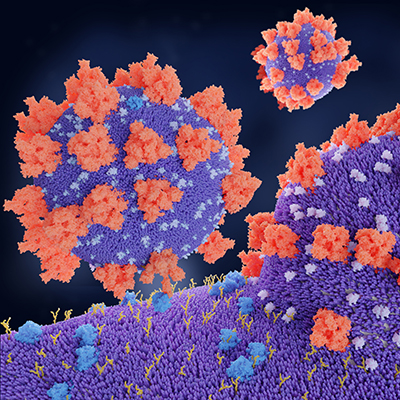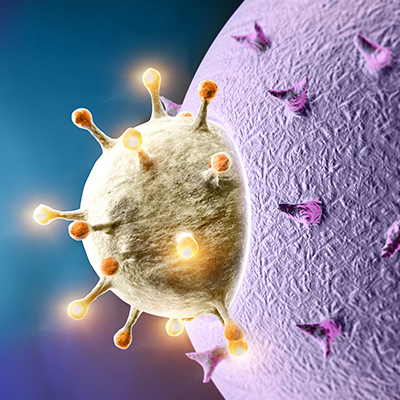October 5, 2020 -- Despite broad interest in determining the origin of SARS-CoV-2 in the early days of the COVID-19 pandemic, the existence of an intermediate host between the source of the virus in bats and humans remains unknown. A study published in Scientific Reports on October 5 provides evidence that 26 species of mammals that are regularly in contact with humans may be susceptible to infection.
Infection with the SARS-CoV-2 virus is facilitated by viral spike protein binding to the angiotensin-converting enzyme 2 (ACE2), and further processing by transmembrane serine protease (TMPRSS2) allows the virus to enter the cell. Several recent studies have suggested that, due to the high conservation of ACE2, some animals are vulnerable to infection by SARS-CoV-2.
In theory, these animals could serve as reservoirs of the virus and increase the risk of future zoonotic diseases, though transmission rates between species are currently unknown. However, the presence of ACE2 alone is not sufficient to cause disease, and variations in other proteins may prevent downstream events that are required for viral replication in a new host.
"We wanted to look beyond just the animals that had been studied experimentally, to see which animals might be at risk of infection, and would warrant further investigation and possible monitoring," said lead author Christine Orengo, PhD, from the University College London (UCL) Department of Structural and Molecular Biology, in a statement.
In order to predict which animals could possibly be infected by SARS-CoV-2 and guide surveillance efforts, researchers from UCL analyzed the effect of known mutations in orthologues (genes evolved from a common ancestral gene) of ACE2 and TMPRSS2 from over 215 vertebrate species including primates, rodents, birds, reptiles, and fish. For each species, they generated a 3D model of the ACE2 protein structure from sequence and calculated the impacts of known mutations in ACE2 to the stability of the spike:ACE2 complex.
The energies of various complexes were correlated to changes in the ACE2 structure, chemical properties of residues in the binding interface, and experimental COVID-19 infection phenotypes from animal studies.
In general, they observed high infection risk, as indicated by a low change in energy (ΔΔG) corresponding to stabilization of animal spike:ACE2 complex compared to human complex.
In line with other in vivo studies, most primates are predicted to be at high risk. In the analysis, all monkeys had high global sequence similarity to humans. In agricultural settings, camels, cows, sheep, goats, and horses also have the potential for infection. In domestic settings, dogs, cats, hamsters, and rabbits have high calculated risk. Other zoological animals such as pandas, leopards, and bears are also at risk for infection.
Importantly, mice and rats do not appear to be susceptible to infection with SARS-CoV-2, which is supported by the fact that hamsters and ferrets are being used as model organisms for human COVID-19 experiments. The researchers found that while many species are susceptible to infection by SARS-CoV-2, most birds, fish, and reptiles are not likely to be.
Humans are likely to come into contact with 26 of the species identified with high risk of infection by SARS-CoV-2. These animals are from domestic, agricultural, or zoological settings. The researchers expressed specific concern about sheep -- which showed no change in energy in complex compared to human complex -- because humans commonly come into contact with these animals on farms.
"The details of host infection and severity of response are more complex than just the interactions of the spike protein with ACE2, so our research is continuing to explore interactions involving other host virus proteins," added Orengo. To this end, the team found that, generally, mutations in TMPRSS2 are less disruptive than mutations in ACE2.
The researchers found several locations that are important for ACE2 binding of the spike protein, namely a hydrophobic cluster near the N-terminus and two hotspot locations near residues 31 and 353, which stabilize the binding interface. Animals with similarities to humans at hotspot 353 in the ACE2 interface (many monkeys) are at increased risk of infection, while variation in the region (as exhibited by dogs and cats) may disrupt the salt bridge and hydrogen bonding.
"Unlike laboratory-based experiments, the computational analyses we devised can be run automatically and rapidly," explained first author, Su Datt Lam, PhD student at UCL and the National University of Malaysia. "Therefore, these methods could be applied easily to future virus outbreaks that, unfortunately, are becoming more common due to human encroachment into natural habitats."
Do you have a unique perspective on your research related to infectious disease research? Contact the editor today to learn more.
Copyright © 2020 scienceboard.net










